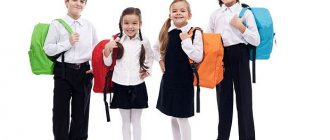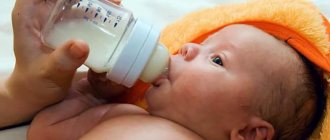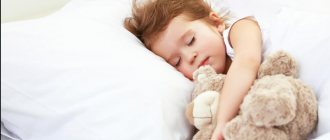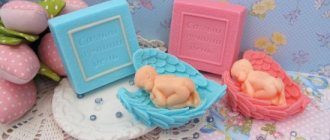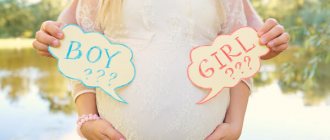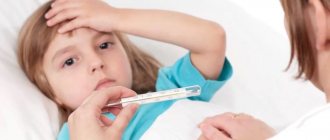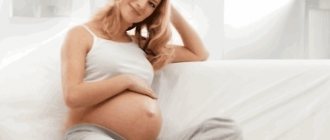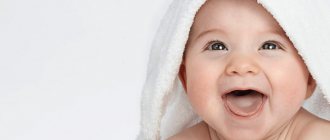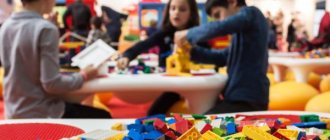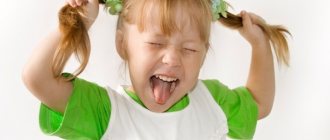We invite you to get acquainted with the main indicators of child development. They will help interested parties (parents, caregivers, teachers) determine the degree of development of a particular child and, if necessary, take appropriate corrective measures.
When compiling these indicators, we used the book’s author Elena Volosova’s own scientific and methodological research, long-term observations of young children, as well as materials from the work “Diagnostics of the neuropsychic development of children in the first three years of life” (TsOLIU doctors, M., 1979) and Basic preschool child development program “Origins” (named after A.V. Zaporozhets, M., 1997).
Cognitive development
Differences between objects in shape, size, color:
Correlates the configuration of a three-dimensional geometric figure with a planar image; places on the sample (places inserts of different sizes or shapes into similar holes on the board).
Orients itself in three or more contrasting sizes (assembles a three-seater nesting doll and other inserts after display).
Assembles a pyramid in descending size from four (five) rings of contrasting sizes (after demonstration).
Focuses on three to four colors; some names; matches the sample.
Begins to recognize the weight, texture, temperature of objects (heavy, light, soft, hard, cold, warm).
Draw vertical, horizontal, round, short and long lines within the sheet. Names what he draws.
Game actions (plot and display):
Shows intelligence: takes out (catch) the toy he likes from the water with a net.
Performs several consecutive game actions or solves the game situation himself after presenting the game material, being in a problem situation (feeds a doll if there are dishes nearby; builds a garage if there are cubes and a car nearby). Uses substitute items.
Performs two consecutive plot actions with a toy (cradles, feeds the doll; carries, loads the car):
- at the request of an adult, without demonstration,
- by imitation.
Imitates the action of a close adult (everyday). Doesn't take a "role".
Constructs familiar buildings for small toys from cubes (fence, house, path, chair, sofa, table, etc.)
- at the request of an adult,
- according to the model
- on one's own.
Plays next to peers with the same toys.
Social-emotional development
Emotional, active, active state.
Well disposed when performing independent skillful actions, with a positive assessment from an adult.
He is stubborn, demanding what is prohibited, insisting on his own.
Dissatisfied, refuses action if the attempt fails.
Screaming, gesticulating, capricious:
- if you are unwilling to comply with an adult’s request,
- imitating a loved one, another child,
- to attract attention.
Disobedient, gets angry when movements are restricted, in response to the rude tone of an adult.
Refuses to communicate (hides) with an unfamiliar adult.
She cries for a long time when her mother leaves, when she is scared, when she is offended.
Smiles, gestures, looks into the eyes to keep the attention of an adult or another child, and expects praise.
Shows vivid emotions when communicating with loved ones (facial expressions, exclamations, movements).
Smiles and uses emotionally charged speech when playing with children.
Gets pleasure from independently pronounced syllables and words.
Emotionally interested in music, singing, small folklore forms, outdoor games, the attitude towards them is differentiated (active movements, looseness, enchantment, inhibition).
Enthusiastic about entertainment, including games.
Shows emotional memory in familiar situations.
He watches cartoons and children's television programs with interest.
Emotionally anticipates results:
- own action,
- actions of an adult.
Empathizes, sympathizes with a crying child, an elderly person, treats animals and plants with care:
- following the example of an adult,
- on one's own initiative (rarely).
Emotionally restrained, able to wait a little (after an adult’s explanation). He is calm about the instructions: “Get the toys”, “this is possible”, “this is not possible”. Understands the words: “good”, “bad”.
Advice from a psychologist to parents on raising a 2-3 year old child
Until the child reaches the age of 2–2.5 years, there is no point in punishing him. He does not yet feel like he is the culprit of the incident. He sees the result of his actions, but does not associate it with himself in any way, and does not realize how it happened. The only thing he will take away from punishment or reproach is that he is bad and is not loved.
Until a certain time, we must refrain from angry tirades and detailed explanations of what not to do. The baby still cannot understand them. At this stage, clear and reasonable restrictions and prohibitions are sufficient.
From about 2.5 years old, the child begins to feel like an independent person, and he is already able to understand who is to blame for the incident. He realizes that some actions are good and make loved ones happy, while others are bad. But he is still learning to control himself, and from time to time he will continue to act contrary.
Often at this age, children have imaginary friends to whom they shift responsibility for bad deeds. This allows the child not to feel guilty about the wrongdoing. It is important to understand the motives for his behavior. To do this, you need to discuss the incident with your child and help correct the situation. This must be done in a calm, friendly tone, then he will not be afraid of punishment and will willingly explain what motivated him.
At the age of three, children often behave badly, defining the boundaries of what is permitted and acting to spite their parents. This gives them a sense of adulthood and independence. If you punish for misdeeds, then instead of obedience the baby will show resistance. It is important to be patient at this stage; over time, the relationship with the baby will improve.
Speech development
Speech understanding:
Understands a short story (without showing actions) about familiar events (about what he did on a walk).
Answers questions about these events. Performs up to three orders (take, carry, put). “He feels sorry” and “helps” at the request of an adult. Knows (shows) the names of parts of the face (lips, teeth, tongue, forehead, ears, cheeks, etc.) and body (arms, legs, back).
Active speech (up to 200-300 differently pronounced words):
Uses sentences of two or three words when communicating with adults and children, when making statements, and in requests.
The phrases are not formatted. Begins to use adjectives and pronouns, prepositions, adverbs. May refer to himself in the third person.
He finishes the quatrains in familiar verses and sings along. In two or three sentences he tells what he sees at the moment. Asking questions. Names the objects in the picture:
- at the request of an adult,
- independently (comments).
Lightened words are replaced with correct ones. Gives an assessment of himself: “good”, “big”, “beautiful”. Says: “goodbye”, “bye”, “thank you”, “hello” in individual pronunciation.
Physical development
Performs as shown, according to verbal instructions, independently:
Steps over several obstacles in alternating steps. Maintains balance when walking on a board lying on the floor.
Goes up and down the stairs of the children's slide. Changes pace: walking to running. Runs with a mincing step. Jumps up.
Holds the ball with one or two hands. Throws the ball at a horizontal target. Catches the ball from close range. Rolls the ball down the hill.
From the book by E. Volosova “Development of an early child” (main indicators), M.: “Linka-Press”, 1999.
Mental development of a child of the second year of life
In a child of the second year of life, intensive development of the mental sphere continues, although somewhat slower than in the first year of life. The duration of wakefulness increases to 4-5 hours.
Normally developing children are very active, are predominantly in a positive emotional state, babble a lot, often smile, laugh, and enjoy communicating with adults.
Walking and other motor skills improve. Actions with objects that a child masters in the first year acquire greater dexterity and coordination: actions with cubes, with a ball, and with insert toys are better. The child imitates adults in a funny way.
The main type of activity of a child of the second year of life is object-based activity, during which the child becomes familiar with the various properties of objects; his sensory development continues.
The play complex of a child of the second year of life should include toys such as: cubes, balls, pyramids, nesting dolls, boards with inserts of various geometric shapes, building materials of various sizes.
The child needs to be constantly guided in play, otherwise he may retain and reinforce primitive, monotonous actions for a long time: he can endlessly roll the car, take cubes in his mouth, transfer toys from one hand to another, etc. Show the child how to use a hammer , scoop, spatula, etc.
Under the guidance of adults, the child perceives his surroundings better: he distinguishes, compares, and establishes the similarity of objects based on their characteristics - color, shape, size. First, according to the model, and then according to the word, he can choose a cube of the required color from two or three colored cubes, or choose a small nesting doll from two or three nesting dolls of different sizes.
At the same time, the child’s memory develops. He not only recognizes, but also remembers objects and phenomena that are currently absent. These memories first arise from some visual situation. For example, pointing to a cup with a broken handle, he says: “Dad beat” (broke). Later, these memories arise from the word. For example, when a child is told: “Let’s go for a walk,” he begins to look for clothes and shoes for walking.
The second year of life is an important stage for the formation of various everyday skills. Accustoming to independently perform hygiene skills: when washing, the child puts his hands under running water, when undressing, takes off tights, takes off and puts on a hat, etc.
During meals, the child sits on a chair himself, eats carefully, uses a spoon, a cup, etc. Teach him to be independent, do not do for him what he can do himself.
Cultivate a love of order. Let the child fold his own toys, his clothes, help clean the house, etc.
Remember that children of the second year of life imitate adults in everything. Therefore, take a closer look at yourself: do you have a desire for order and discipline?
At the reception, the mother asks: “What should I do with the child, he doesn’t clean up after himself, he does his homework until 12 at night, he’s somehow disorganized!” I asked this mother, does she like order, is she organized? “Yes, I myself am very disorganized, but I want the child to be different.” It doesn't happen that way. It is difficult to cultivate those qualities that you do not possess yourself.
Be very attentive to your child when he begins to walk independently. For his safety, check all possible routes of movement even more strictly than before and remove anything that could harm the child. If you spend all day, without taking your eyes off him, repeating: “Don’t touch, don’t take, don’t go,” the child will become nervous, and your life will turn into hell.
A child of this age still switches easily. You just have to show him, for example, a bird, and he has already forgotten what he was doing before. But sometimes you need to punish the baby: if he violates your prohibition, you can lightly spank him. The main thing is that the punishment follows immediately after the child has done something wrong.
If you want your child to obey you and be disciplined in the future, do not waste time - then it will become more and more difficult.
The second year of life is the time of formation and rapid improvement of speech functions (the basis of all mental development), that is, it is a sensitive period for the development of speech.
Up to one and a half years, the function of understanding speech develops, and then, up to two years, there is an increase in vocabulary and active speech. Significant speech and facial expressions are significantly enriched during this period. One word from a child often expresses an entire phrase. For example, the word “on” can mean either “take me in your arms” (while reaching out to an adult), or “sit me on a chair” (slams his hand on the chair).
In unusual conditions or with unfamiliar people, a child of this age is usually silent and behaves warily. It’s as if he feels that only his mother can understand him. Mom knows that “ka” is a car, “zi-zi” is a fly, “di-ba” is everything tall and big, “ba-bah” is a tank, and “ava” is a horse.
However, parents should no longer be so perceptive and continue to understand their child perfectly. After one and a half years, try to ensure that the baby pronounces the entire word and accurately expresses his desires.
An overprotective mother who guesses the child’s wishes even before he expresses them slows down his speech. With normal speech development, by the end of the second year, the child’s vocabulary increases to 300 words, and it no longer includes only the names of objects, but also their qualities, and then phrasal speech appears.
The famous psychotherapist V.I. Garbuzov said: “Both a future genius and a mentally retarded person pronounce the first words at the same time, but the first phrase of two words is pronounced at one and a half years old, and even more so one phrase of three or four words by two years of age.” can only be built by a mentally intact, intellectually complete child.”
Of course, parents begin to worry if their child is not yet speaking at two years old.
First, you need to keep in mind that boys start speaking later than girls. In girls, phrasal speech can appear at one and a half years, and in boys only at two years.
Secondly, there are individual characteristics in the dynamics of development of all mental functions, including speech. Children who begin to speak later than others often speak more correctly and clearly. But this happens when the child has well-developed cognitive abilities, well-developed motor skills, if he hears and understands speech addressed to him.
Therefore, if a child does not speak at two years old, be sure to consult with specialists in the field of child psychology and speech therapy.
If for some reason (illness, lack of communication) the child’s speech capabilities are not used to a sufficient extent, then his further intellectual development begins to be delayed, since the development of speech is most closely related to the development of mental functions.
The development of thinking at this age occurs in the process of its objective activity and is of a visual and effective nature.
The child learns to move objects in space, to act with several objects in relation to each other. Thanks to this, he becomes acquainted with the hidden properties of object activity and learns to act with objects indirectly, that is, with the help of other objects or actions (for example, knocking, rotating, etc.).
Such activity of the child creates the conditions for the transition to conceptual, verbal thinking. That is, in the process of performing actions with objects and denoting actions with words, thought processes are formed: the child learns to correlate tools with the object to which the action is directed (with a shovel he picks up sand, snow, earth, with a bucket - water). In this way, the child adapts to the properties of the object.
Among the thought processes of a child of this age, generalization is of greatest importance. But since the child’s experience is still small and he does not yet know how to identify an essential feature in a group of objects, generalizations can be incorrect. For example, a child uses the word “ball” to designate all objects that have a round shape. Children of this age can make generalizations based on a functional basis: a hat is a hat, a scarf, a cap, etc. They compare, differentiate (“Mom is big, and Anyutka is small”), and establish a connection between phenomena (“The sun is bright—let’s go play.”)
The nature of play activity is significantly enriched in the second year of life. First, for example, the child feeds and lulls the doll, and then these actions are transferred to other objects: he “feeds” not only the doll, but also the dog and the bear cub.
Imitative play develops. The child begins to “read” the newspaper, “comb his hair,” “dress up,” etc. In such games, a plot already appears, consisting of several interconnected actions. With some guidance from adults, the child shows interest in the actions of other children and emotionally communicates with them.
But the child still has a great need to communicate with an adult. His emotional state, his activity, his development are directly dependent on how often adults play and talk with him. Tests of the mental development of a child of the second year of life.
From a year to fifteen months.
1. Test with cubes.
Offer your child 8cc cubes. Show him how to stack one cube on top of another to form a tower. Give him the opportunity to build the tower himself. A child at fifteen months of age does not put blocks in his mouth, does not throw blocks on the floor, but completes the task exactly.
2. Test with geometric shapes.
To perform this test, you need a board with slots for three geometric shapes (circle, triangle, square). The place of each piece on the board is determined by the cell corresponding to its outline. You can make such a board yourself or purchase it in a store. (Geometric construction sets, cubes or balls with geometric shapes cut out in them are now sold.)
Start with the easiest task. In front of the child, take out three figures from the cells of the board and give the circle into the baby’s hands: “Place this circle in the hole of the board so that it is smooth.” If the child does this task incorrectly and tries to put the circle in another hole, move his pen along the figure on the board with the words: “You see, it turned out somehow uneven, but you need the board to become smooth.” If the child places the figure correctly, slowly turn the board over and tell him: “Place the circle in the hole again,
so that the board becomes smooth.” Praise your child. At fifteen months of age, the child copes with the task of nesting a circle.
3. Pyramid test.
Show your child a correctly assembled pyramid, and then ask him to make the same one. For a few minutes, refrain from prompting and watch your baby work independently.
Often the child incorrectly takes into account the sizes of the rings of the pyramid and does not correlate their sizes in sequence. It is very good if, having noticed a mistake made, he eliminates it, and does not destroy the entire building.
If all attempts are unsuccessful, help the child: “You see, it didn’t work, don’t forget that you need to take the largest ring first, then the smaller one...” At fifteen months, the child tries to string pyramid rings, but without taking into account their size.
4. Test with household items.
At fifteen months, a child can perform many actions with various household objects. He can already use a spoon, bring it to his mouth; he drinks from a cup.
5. Test for the development of the motor sphere (gross motor skills).
After a year, the child walks independently and for a long time. He can squat, bend, crawl up the stairs, get on and off the couch, and can get up from his knees.
From fifteen to eighteen months.
1. Test with cubes.
Offer your child four 8 cc blocks and ask him to build a tower. If he can't do it on his own, show him how to stack one cube on top of another to build a tower.
Then ask him to build a train (four cubes in a row), a bridge (one cube stands on two others).
Observe your child’s actions every time and don’t rush to correct him. It is important how the child understands you, how he corrects mistakes, and how he learns. At eighteen months, a good result for a child will be the ability to build a tower of three or four cubes.
2. Test with geometric shapes.
A board, cube or ball with slots for a circle, triangle and square is used. You take the pieces out of the slots and invite the child to put them back in so that the board is smooth.
A child at eighteen months usually places the circle correctly, and places two other figures on top of it.
3. Pyramid test.
In front of the child's eyes, scatter the pyramid and ask him to put it back together (the pyramid consists of two rings). Observe the child’s independent actions, whether he is able to carry out purposeful activities, detect errors and correct them. However, it should be borne in mind that, on average, a baby of eighteen months assembles a pyramid, but still cannot take into account the correct sequence, that is, he assembles a pyramid without taking into account the sizes of the rings.
4. Test with household items.
A one and a half year old child can already: take off his mittens, socks, slippers, hat; eat thick food yourself with a spoon.
5. Test for the development of the motor sphere (gross motor skills).
At one and a half years old, a child can usually go up and down stairs on his own, can carry toys with him, and can step over a stick lying on the floor.
6. Test to assess fine motor skills of the fingers.
Give your child a piece of paper and a soft pencil. Show how you can draw a horizontal and vertical line. A one and a half year old child repeats a stroke that vaguely resembles a straight line.
7.
Memory test.
Ask your child to perform several actions in a row: get up from the chair, walk around the table, take a book, give it to mom. A one and a half year old child can already remember and reproduce 3-4 actions from memory.
8. Test for assessing the speech sphere.
Show your child a few simple objects: a bottle, a doll, a car, a ball, a cup. Ask him: “What is this?” At one and a half years old, a child can name at least one object.
Eighteen months to two years.
1. Test with cubes.
Use the same 8cc cubes in quantities of 10. A two-year-old child can independently build a tower using eight blocks, and after a demonstration, build a train without a pipe.
2. Test with geometric shapes.
Using a familiar board, a two-year-old child can already cope with the entire task, correctly placing all three geometric shapes (circle, triangle, square) on the board. In this case, the result may not be achieved immediately; the child may make about four erroneous trials.
3. Pyramid test.
With some prompting, the child completes the task and correctly strings two rings onto the pyramid, taking into account the size. But it becomes difficult if he sees more than two objects in front of him.
4. Test with household items.
A two-year-old child can insert a key into a keyhole, turn a door handle, press a bell button, “feed” and cradle a doll, drive a car, put on socks, shoes, and panties.
5. Test for the development of the motor sphere (gross motor skills).
A two-year-old baby already controls his body quite well. He can pick up a toy from the floor by bending down; steps over obstacles, alternating steps; kicks the ball; can walk on a surface 15-20 cm wide; can climb onto a chair to reach a toy.
6. Test to assess fine motor skills of the fingers.
At two years old, a child can already imitatively (after showing it to an adult) repeat drawing vertical and circular lines.
7. Memory test.
A two-year-old child can remember and repeat about four actions. Ask him to perform several actions in a row: get up from the chair, go to the table, take a pencil from the table, bring the pencil and put it on the chair.
8. Vocabulary test.
Show your child a few simple objects: a bottle, a doll, a shoe, a car, a ball, a cup. Ask him: “What is this?” A two-year-old child names from 2 to 5 objects correctly.
9. Test for recognizing images by name.
While looking at a book with your child, show him pictures depicting: a cat, a dog, bread, a rooster, a dress, a spoon, an apple. Ask: “Where is the cat?” or “Show me the cat, the dress, etc.” A two-year-old child can correctly point to 5 pictures.
10. Picture naming test.
Show your child pictures depicting: a cat, a dog, a spoon, an apple, a cup, a car, a table, a ship, a train, a bus, an airplane, socks, boots, a lemon, a pear, a watermelon, a boy, a girl, an aunt, an uncle, a grandmother, a grandfather, duck, cow, horse, kettle, pan, bed, knife, fork, pencil, newspaper, book. Ask, showing each picture separately: “What is this?” or “What is drawn here?” The child names three or four pictures correctly.
11. Test for understanding instructions.
Pages: 1
Full-width / Middle / Regular Print Version
